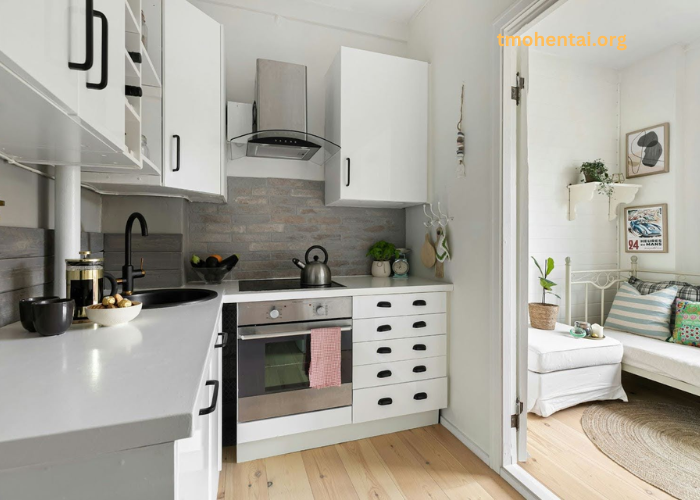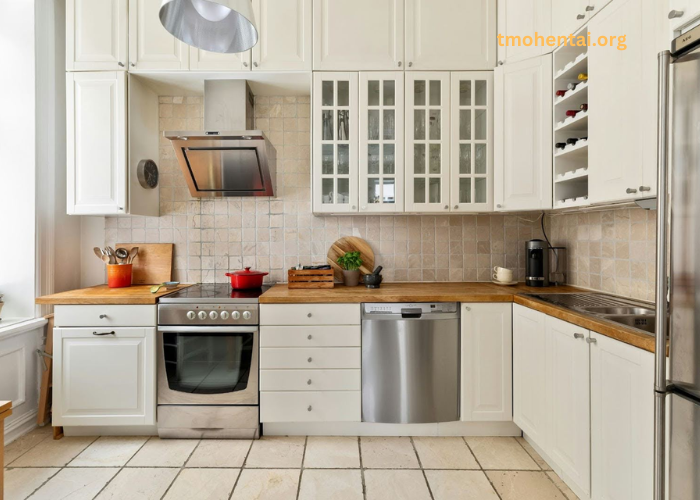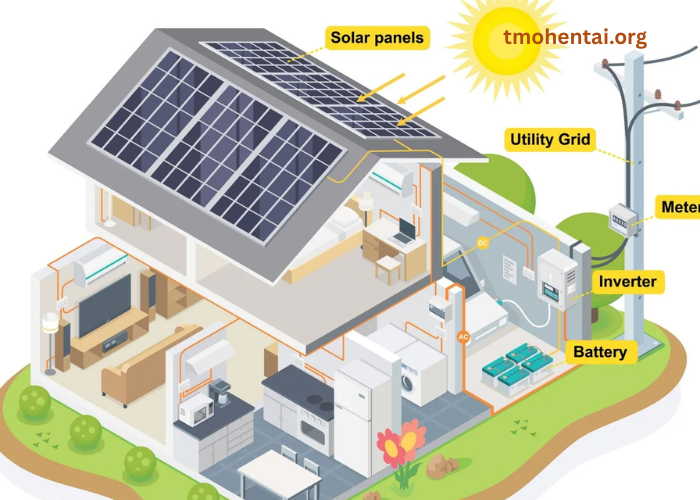Want to know how to design a kitchen that truly fits your lifestyle? Start by assessing your needs, optimizing your space, and selecting the right layout. This guide will walk you through these steps to create a functional and stylish kitchen.
Assess Your Kitchen Needs
The first step in designing a kitchen layout is to assess your specific needs. The way you utilize your kitchen will have a major impact on your design decisions. Your cooking habits and lifestyle will dictate many of your choices. Think about the key functions of your kitchen, which include:
- Storage space
- Food preparation
- Cooking
- Refrigeration
- Cleaning These are the cornerstones of any functional kitchen and should be prioritized during the planning phase.
Next, think about your personal and family needs. How many people will the kitchen need to accommodate? How frequently do you cook? These questions will help you determine the amount of counter space, storage, and seating you require. For instance, a family that loves to cook together might need more counter space and multiple people work stations, whereas a single person might prioritize a sleek, modern design with minimal clutter.
Proper planning is crucial to ensure your kitchen incorporates features that are important to you. This might include a specific layout, particular appliances, or even a design a kitchen style that reflects your personality. Kitchen planning involves thoroughly assessing your needs and lays the foundation for a functional kitchen tailored to your lifestyle, following a careful design process.
Understanding the Kitchen Work Triangle
The kitchen work triangle is a fundamental concept in kitchen design that can significantly enhance efficiency and flow. The three points of this kitchen triangle are the sink, cooktop, and refrigerator. Ideally, each side of the triangle should measure between 4 to 8 feet, promoting easy movement between these key areas.
The triangle’s perimeter should be between 13 to 26 feet for optimal flow. This ensures that your kitchen is neither too cramped nor too spread out. Avoid placing obstacles, such as tall cabinets, within the triangle’s pathway, as this can disrupt the workflow. Even in smaller spaces, a thoughtfully arranged work triangle can make all the difference.
Incorporating the kitchen work triangle is still crucial for modern kitchens, as they serve multiple functions. Keeping the triangle clear of other appliances and items helps maintain its integrity, preventing people from bumping into each other when cooking. Following this principle ensures a kitchen layout that is both efficient and user-friendly.
Plan for Traffic Flow and Accessibility
A well-designed kitchen layout should facilitate smooth traffic flow and accessibility. When planning a kitchen island, consider the following:
- Ensure there is enough clearance around the island for easy movement.
- Provide access to adjacent areas without obstruction.
- Maintain a minimum clearance of 1.2 meters between kitchen islands and counters.
Paths through the kitchen should be unobstructed to facilitate smooth movement between work areas. Proper placement of kitchen appliances, such as the refrigerator, is essential for both the cook and guests to access easily. In a small space kitchen, opting for compact small appliances can help maintain a functional layout with enough space and an open floor plan.
Effective kitchen design should also prevent traffic from crossing major work zones, enhancing workflow. A kitchen designer can help create designated landing areas around appliances to facilitate placing hot dishes or prepping ingredients easily. Considering these factors during planning results in a kitchen and dining areas that offers easy access and is efficient.
Maximize Counter Space
Counter space is a precious commodity in any kitchen. One effective way to maximize it is by covering the stovetop with custom-made work surfaces, transforming it into an additional workspace. Similarly, a large cutting board placed over the sink can provide more prep space when needed.
Kitchen design ideas to maximize functionality and storage, including kitchen layout ideas:
- Extending benchtops into an island to create a multifunctional area.
- Using a deep windowsill as extra storage for kitchen essentials, keeping counters clearer.
- Incorporating kitchen design tips, such as installing a rail along the backsplash to hang utensils and tools, reducing counter clutter.
Including open shelves can help store items when not in use, maximizing counter space. Positioning cooking essentials like oils and spices near the range aids effective meal preparation for cook meals. Incorporating these strategies ensures ample cook space for all your culinary endeavors.
Prioritize Storage Solutions
Storage solutions are key to maintaining a clutter-free kitchen. Exploiting vertical space by utilizing areas above upper cabinets can help store less frequently used items. Incorporating corner open shelves can enhance your kitchen’s storage capacity while making use of often overlooked spaces.
Practical features for wall storage in the kitchen can include:
- Open shelves
- Wall hooks
- Overhead pot racks
- A magnetic strip on the backsplash, which serves as an effective solution for storing knives safely and clearly visible
- Pull-out waste basket cabinets that can conceal trash effectively, maintaining a tidy appearance.
Integrating various storage solutions effectively can lead to a clutter-free kitchen that’s both functional and aesthetically pleasing. From optimizing drawer space with organizers to using portable kitchen carts, there are numerous ways to enhance your kitchen’s storage capacity. Prioritizing storage results in a kitchen that is organized and efficient.
Choose the Right Kitchen Layout
Selecting the right kitchen layout is crucial for creating a functional cooking space. There are five common kitchen layouts:
- Galley
- Single line
- U-shaped
- L-shaped
- Island kitchens Each layout has its own set of advantages and is suited to different space and lifestyle needs.
Different kitchen layouts include:
- Galley kitchens: Narrow with cabinets on one or both sides of a central walkway, making them space-efficient.
- u shaped kitchen: Cabinets on three walls, optimizing workspace efficiency and providing ample counter space.
- L-shaped kitchens: Use two walls and are ideal for open-plan living areas, offering flexibility in design.
To further elevate your layout, consider installing custom kitchen cabinets that match your specific storage needs and style preferences. They can be tailored to fit unconventional spaces or complement the flow of your chosen layout, making the kitchen not only beautiful but highly efficient.
Incorporate a Functional Kitchen Island
A kitchen island can enhance workflow by adding counter space within the triangle. When determining the design of a kitchen island, consider its intended function—whether it will be used for cooking, eating, or both.
Plan for adequate space separating the cooktop from the eating area if the island serves both functions. A kitchen island can accommodate additional elements such as a main sink, bar sink, or dishwasher to enhance its functionality.
The ideal size range for a kitchen island is between 2m to 3m long and 1.1m to 1.4m wide for effective use. Incorporating a kitchen island thoughtfully creates a multifunctional hub.
Optimize Appliance Placement
Strategic appliance placement is essential for a functional kitchen layout. When placing refrigerators, consider the following:
- Ensure they are easily accessible for both passersby and those working in cooking areas.
- Make them reachable for individuals involved in cleanup.
- Leave space for pipes and cables.
- Avoid placing the fridge too close to walls.
Cooking appliances can vary from upright cookers to separate ovens and cooktops. Maintain at least 15 inches of countertop on each side of a cooktop and refrigerator for optimal landing space in the cook’s area. Appliances should be strategically placed within their functional cooking zone for efficient workflow.
In kitchens where children are present, consider the following for safety and efficiency:
- Place the microwave below the countertop.
- Plan for large appliances first since they have fixed dimensions.
- Fit other items around the large appliances.
Optimizing appliance placement ensures a kitchen that’s both efficient and safe.
Focus on Lighting
Good lighting in a kitchen ensures workspaces are properly lit and creates a warm atmosphere, aiding visibility during food prep and clean up. Incorporating ambient, task, and accent lighting is essential, with recommended fixtures including under-cabinet strip lighting, pendant lights, and wall lights.
Proper task lighting should be positioned directly above work areas such as countertops to minimize shadows. Aesthetic lighting options like statement fixtures can significantly change the kitchen’s vibe, and layered lighting enhances visibility by combining multiple light sources.
Focusing on natural light creates a dream kitchen that balances beauty and functionality.
Select Durable and Stylish Materials

Choosing durable materials for countertops, cabinets, and flooring is essential to balance beauty and practicality in kitchen design. Recommended countertop materials include quartz, known for its durability and low maintenance. Caesarstone engineered stone benchtops offer premium quality with features like scratch, stain, and heat resistance.
Selecting materials for kitchen cabinets impacts both functionality and aesthetics, with solid timber and MDF as popular choices. Plywood differs in durability based on its grade, making it a variable option for cabinetry.
Selecting durable and stylish materials ensures a kitchen floor that stands the test of time.
Integrate Advanced Features
Modern kitchen upgrades can include features like an instant boiling water tap and a steam oven. A boiling water tap offers immediate access to hot water, making tasks like tea or cooking pasta faster and more convenient.
Steam ovens provide healthier cooking options by preserving nutrients and flavor while reducing the need for oils. The Quooker PRO3 is a popular model of an all-in-one boiling water tap, known for its efficiency and convenience. Integrating advanced features enhances your kitchen’s functionality and convenience.
Add Character with Finishing Touches
Adding character to your kitchen with finishing touches can personalize the space. Choose elements that tie in with your home and lifestyle to create a seamless finish. Key focal points in kitchen design include backsplashes, flooring, and patterned countertops that enhance aesthetic appeal.
Selecting stylish handles for cabinetry, such as polished chrome or matte black, can elevate the overall design. Incorporating potted plants or fresh herbs can enhance the kitchen’s atmosphere and add a touch of life.
For homes with open-plan kitchens leading into living areas, maintaining visual harmony is essential. This includes cleanliness beyond just the kitchen.
Regular carpet cleaning in Melbourne can help keep adjoining spaces fresh and visually consistent, especially in high-traffic homes where kitchen activity spills over into living areas.
Focusing on personal style over trends helps maintain a timeless kitchen design.
Summary
Summarize the key points covered in the guide, emphasizing the importance of assessing your needs, understanding the kitchen work triangle, planning for traffic flow, maximizing counter space, prioritizing storage solutions, and choosing the right kitchen layout. Highlight the benefits of incorporating a functional kitchen island, optimizing appliance placement, focusing on lighting, selecting durable materials, integrating advanced features, and adding character with finishing touches.
End with an inspiring call to action, encouraging readers to start their kitchen design journey and create a space that is both functional and beautiful.
Frequently Asked Questions
What is the kitchen work triangle and why is it important?
The kitchen work triangle is a crucial design concept that connects the sink, cooktop, and refrigerator to enhance efficiency in meal preparation. By minimizing movement between these key areas, it significantly streamlines cooking tasks and improves workflow.
How can I maximize counter space in a small kitchen?
To maximize counter space in a small kitchen, consider using custom-made surfaces over the stovetop and placing a large cutting board over the sink. Additionally, extending benchtops into an island and utilizing deep windowsills for storage can effectively enhance your workspace.
What are some effective storage solutions for a clutter-free kitchen?
To achieve a clutter-free kitchen, consider utilizing vertical space above cabinets, installing corner open shelves, and incorporating wall hooks and overhead pot racks. These solutions not only maximize storage but also enhance the kitchen’s organization and functionality.
What are the benefits of incorporating a kitchen island?
Incorporating a kitchen island enhances your space by providing additional counter space, allowing for easy meal preparation and dining, while also offering functional options like a sink or dishwasher. This multifunctional area can greatly improve the efficiency and aesthetics of your kitchen.
How important is lighting in kitchen design?
Lighting is essential in kitchen design, as it enhances visibility for tasks, creates a welcoming atmosphere, and significantly improves the overall functionality of the space. Properly combining ambient, task, and accent lighting is key to achieving a well-designed kitchen.





